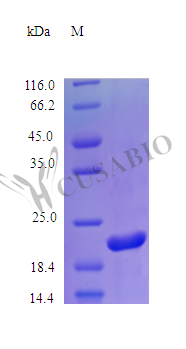Recombinant Human Somatotropin protein (GH1) gets produced in E. coli and represents the full length of the mature protein from amino acids 27 to 217. This tag-free product appears to be highly pure, achieving greater than 98% purity as determined by SDS-PAGE. The protein exhibits full biological activity, with an ED50 of less than 0.1 ng/ml in a cell proliferation assay using rat Nb2-11 lymphoma cells, and shows specific activity greater than 1.0 × 10^7 IU/mg. Endotoxin levels stay below 1.0 EU/µg as confirmed by the LAL method.
Somatotropin, also known as growth hormone (GH), plays a crucial role in regulating growth and metabolism. Various physiological processes get influenced by this protein through promoting cell growth, reproduction, and regeneration. Research areas focusing on growth disorders, metabolic functions, and cellular development find this protein particularly valuable. Understanding growth-related pathways may depend significantly on this tool for scientific studies.
Potential Applications
Note: The applications listed below are based on what we know about this protein's biological functions, published research, and experience from experts in the field. However, we haven't fully tested all of these applications ourselves yet. We'd recommend running some preliminary tests first to make sure they work for your specific research goals.
1. Cell Proliferation and Growth Assays
This recombinant human somatotropin (GH1) is confirmed to be highly biologically active (ED₅₀ < 0.1 ng/ml in rat Nb2-11 cells) and suitable for proliferation studies. However, researchers should validate its activity in human-specific cell lines to ensure cross-species reactivity is consistent, as the validation data is from rat cells. The high purity (>98%) and low endotoxin levels support reliable dose-response experiments, but optimal concentrations may need adjustment for different cell types based on growth hormone receptor expression levels.
2. Growth Hormone Receptor Binding Studies
The biologically active GH1 is appropriate for receptor binding studies, and the tag-free design (as no tag is mentioned) ensures authentic interactions with the growth hormone receptor (GHR). The high specific activity (>1.0×10⁷ IU/mg) confirms proper folding for binding assays. However, researchers should validate binding kinetics in human GHR systems to complement the rat cell activity data, as species-specific affinity differences may exist.
3. Antibody Development and Validation
This high-purity, full-length GH1 (27-217aa) serves as an excellent antigen for antibody development. The confirmed bioactivity indicates proper folding for conformational epitope recognition. However, antibodies should be validated against native human growth hormone from biological sources (e.g., pituitary extracts) to ensure recognition of physiologically relevant forms, though GH1 is not glycosylated, minimizing concerns about PTM differences.
4. Biochemical Characterization and Protein Interaction Studies
The protein is suitable for biochemical studies due to its high purity and activity. The E. coli expression produces a non-glycosylated protein, which is ideal as native GH1 is not glycosylated, ensuring structural relevance. However, researchers should note that the protein may have different solubility or stability profiles compared to mammalian-expressed GH1 in some buffer conditions, though the high specific activity suggests proper folding.
5. Preclinical Research Models
This GH1 can be used in preclinical models, but the human sequence may elicit immune responses in animal studies, potentially confounding results. The activity in rat cells supports use, but researchers should include species-matched controls (e.g., rat GH) for comparative studies and monitor for immunogenicity over long-term experiments.
Final Recommendation & Action Plan
This recombinant human somatotropin (GH1) is a high-quality reagent with validated high potency, making it suitable for all proposed applications. For immediate use, employ it at low concentrations (0.01-0.1 ng/ml) based on the ED₅₀ for proliferation assays, but optimize doses for specific cell types and endpoints. The tag-free design ensures reliable binding and interaction studies, but validates kinetics in human systems where possible. For antibody development, this protein is ideal due to its purity and activity, but confirm specificity against native GH. The E. coli expression is appropriate as GH1 is non-glycosylated, minimizing structural concerns. In preclinical models, use human GH with caution and include controls for species-specific effects. Always include proper controls and dose-response curves to ensure data reliability.






